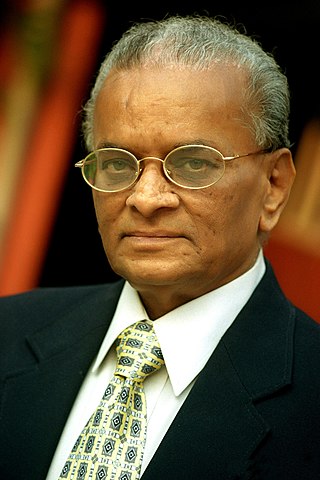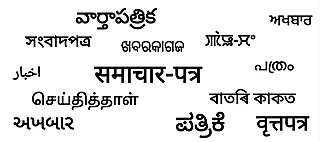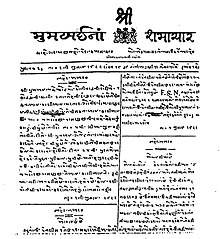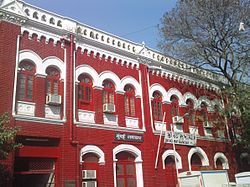
The Parsis or Parsees are an ethnoreligious group of the Indian subcontinent adhering to Zoroastrianism. They are descended from Persians who migrated to Medieval India during and after the Arab conquest of the Persian Empire to escape religious persecution. The Parsi people comprise the older of the Indian subcontinent's two Zoroastrian communities vis-à-vis the Iranis, whose ancestors migrated to British-ruled India from Qajar-era Iran. According to a 16th-century Parsi epic, Qissa-i Sanjan, Zoroastrian Persians continued to migrate to the Indian subcontinent from Greater Iran in between the 8th and 10th centuries, and ultimately settled in present-day Gujarat after being granted refuge by a local Hindu king, Jadi Rana.
Behram Contractor, popularly known as Busybee, was an Indian journalist, humorist, and the founding editor of The Afternoon Despatch & Courier, a weekly that was published in Mumbai between 1985 and 2019.

Bhikaiji Rustom Cama or simply as, Madam Cama, was one of the prominent figures in the Indian independence movement.

Sir Pherozeshah Merwanjee Mehta was an Indian politician and lawyer from Bombay. He was knighted by the British Government in India for his service to the law. He became the Municipal commissioner of Bombay Municipality in 1873 and its president four times – 1884, 1885, 1905 and 1911. Mehta was one of the founding members and President of the Indian National Congress in 1890 held at Calcutta.

Mid-Day is a morning daily Indian compact newspaper owned by Jagran Prakashan Limited. Editions in various languages including Gujarati and English have been published out of Mumbai, Delhi, Bangalore and Pune so far. In 2011, the Delhi and Bangalore editions were closed down. In 2014, Jagran Prakashan shut down the midday Pune edition as well.

Chandrakant Keshavlal Bakshi was an Indian Gujarati-language author from Gujarat, India and a former Sheriff of Mumbai. He was known for his bold and new concepts in writing during his time in Gujarati literature. He is also addressed as Bakshi or Bakshibabu. Born in Palanpur, he completed higher education and had a business in Calcutta. He started writing there and later moved to Mumbai for his teaching career. He wrote 178 books, and wrote extensively in newspaper columns.
Fardunjee Marzaban or Fardoonjee Marazban was, among other things, a printer and a newspaper editor. He established the first vernacular printing press in Bombay, India. He also started India’s oldest running periodical called the Bombay Samachar, which was printed primarily in Gujarati. He pioneered vernacular journalism in India, as also the production of Gujarati types.

The Gujarat Samachar is the leading Gujarati-language daily newspaper published in India. Its headquarters are in Ahmedabad with a branch in Surat. It is distributed from Ahmedabad, Vadodara, Surat, Rajkot, Bhavnagar, Mumbai, Mehsana, Bhuj and New York City.

Sandesh is a leading Gujarati daily newspaper that started publications in Ahmedabad, Gujarat in 1923. It has the second largest readership in Gujarat as of 2019 according to the Indian Readership Survey. The paper focuses coverage on local and regional stories consequential to the various city editions in print, published from Vadodara, Surat, Rajkot, Bhavnagar, and Bhuj. The newspaper was purchased from the founder in 1958 by Chimanbhai S. Patel and has since been a core business division of 'The Sandesh Limited'.
Jam-e-Jamshed is a weekly Mumbai newspaper published partly in Gujarati and mainly in English. The Jam-e-Jamshed is the second oldest newspaper in Asia. The paper was originally published as a weekly from 12 March 1832. In 1853, it was converted into a daily but facing financial pressures in the 1960s it yet again became a weekly.
The Serampore Mission Press was a book and newspaper publisher that operated in Serampore, Danish India, from 1800 to 1837.
Gujarati theatre refers to theatre performed in the Gujarati language, including its dialects. Gujarati theatre is produced mainly in Gujarat and Maharashtra, in cities like Mumbai, Ahmedabad and Baroda, Surat and elsewhere Gujarati diaspora exists, especially North America. Rustam Sohrab, performed by Parsee Natak Mandali on 29 October 1853 in Mumbai, marked the beginning of Gujarati theatre.

Kharshedji Rustomji Cama (1831–1909), often known as K. R. Cama, was an Indian Parsi scholar and reformer from Bombay.

The Media in Gujarati language started with publication of Bombay Samachar in 1822. Initially the newspapers published business news and they were owned by Parsi people based in Bombay. Later Gujarati newspapers started published from other parts of Gujarat. Several periodicals devoted to social reforms were published in the second half of the 19th century. After arrival of Mahatma Gandhi, the Indian independence movement peaked and it resulted in proliferation of Gujarati media. Following independence, the media was chiefly focused on political news. After bifurcation of Bombay state, the area of service changed. Later there was an increase in readership due to growth of literacy and the media houses expanded its readership by publishing more editions. Later these media houses ventured into digital media also. The radio and television media expanded after 1990.
Adi Pherozeshah Marzban (1914–1987) was an Indian Gujarati Parsi playwright, actor, director, broadcaster known for his efforts in modernizing Parsi theatre. He was awarded the Padma Shri, the fourth highest civilian award of India in 1964 and Sangeet Natak Akademi Award in 1970.
Esha Dadawala is a Gujarati language poet and journalist from Gujarat, India. Her significant works include Vartaro (2008), Kya Gai Ae Chhokri (2011) and Janmaro (2013). She has won Yuva Gaurav Award of 2013 for her contribution in Gujarati literature.

Gulfam, born Jahangir Nasharvanji Patel alias Pestonji, was a Gujarati humour writer and journalist from Bombay, India.
Rast Goftar was an Anglo-Gujarati paper operating in Bombay that was started in 1854 by Dadabhai Naoroji and Kharshedji Cama and championed social reform among Parsis in Western India.
The Indian National Theatre (INT) is a theatre organisation and troupe founded in 1943 and based in Mumbai, India. Although performing predominantly Gujarati theatre, the troupe has also produced a number of plays in other Indian languages. In addition to theatre productions, the troupe also carries theatre education, training and research activities.
The Parsi–Muslim riots occurred in 1851 in Bombay, and were reprised in 1874 in parts of Gujarat. These marked the beginning of a period of tension in the two communities. The first riot took place over the blurred depiction of the Islamic prophet, Muhammad, and his appearance in a public print by a Parsi newspaper, Chitra Gyan Darpan, in October 1851. A second riot place on May 1857,over a Parsi named Bejonji Sheriaiji Bharucha was accused of disrespecting a mosque by some Muslims. A third riot took place on 13 February 1874, over an article on the life of Muhammad in a book entitled Famous Prophets and Communities.












